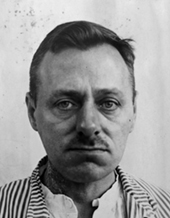Search for Names, Places and Biographies
Already layed Stumbling Stones
Suche
Bruno Niemann * 1898
Schulterblatt 24 (Altona, Sternschanze)
HIER WOHNTE
BRUNO NIEMANN
JG. 1898
EINGEWIESEN 1939
ALSTERDORFER ANSTALTEN
"VERLEGT" 1943
HEILANSTALT MAINKOFEN
ERMORDET 19.5.1945
further stumbling stones in Schulterblatt 24:
Lina Friedmann, Adolf Gustav Ziebarth
Bruno Niemann, born on 4 Apr. 1898 in Hamburg, admitted on 28 Aug. 1939 to the then Alsterdorf Asylum (Alsterdorfer Anstalten), "transferred” on 11 Aug. 1943 to the "sanatorium and nursing home” in Mainkofen ("Heil- und Pflegeanstalt Mainkofen”), died on 19 May 1945
Schulterblatt 24
Bruno Niemann was a son of the tailor Friedrich Niemann and his wife Eliese, née Demperwulf. He had three siblings.
Between the ages of two and seven years, he had to be treated several times at the Marienkrankenhaus hospital for osteomyelitis in both arms and other ailments such as bone decay. The diseases severely impaired his development and led to him being classified as having a degree of disability at 30 percent. As a result, he attended the eight-grade elementary school (Volksschule) at Kielortallee 18 only up to the third grade (corresponds to today’s sixth grade). This was followed by an apprenticeship for one year in a toy and fancy goods (Galanteriewaren) factory (fancy goods: outdated term for fashion accessories such as fashion jewelry).
Afterward, he earned a living as an unskilled worker performing diverse messenger services and he was unemployed for a long time. From 1915 to 1918, he worked in the Düneburg gunpowder factory in the Besenhorster Sandberge (Besenhorst sand hills) west of Geesthacht, then lost his job again and found work in a gunpowder factory in Dormagen in the Rhineland.
In Dec. 1919, Bruno Niemann and Alma Unger married. The marriage produced a daughter, who was born in 1920. In the following years, Bruno Niemann tried to start his own business with a bread shop and other small enterprises. This remained without success. He then carried out unskilled work in the port of Hamburg and from 1933 on at the Reichspost, the Reich Postal Service, where he later became a sorter.
Bruno Niemann’s life changed dramatically when he became a patient of the "Psychiatric and Mental Hospital of the Hansische University” ("Psychiatrische und Nervenklinik der Hansischen Universität”) in Hamburg-Friedrichsberg in Mar. 1938. At that time, he lived together with his wife at Schulterblatt 24, House 6, where he had demolished several sections of his apartment in a fit of severe agitation. He had subsequently been arrested by the police after smashing a fire alarm. At the clinic, he reported a strong aversion to certain colors and the urge to throw away everything he deemed dirty, dusty, and outdated. He often dreamt of fire and believed that his colleagues were talking about him and had been at home with his wife and daughter in his absence. He expressed strong feelings of jealousy.
Finally, in 1938 Bruno Niemann was committed to the Farmsen care home (Versorgungsheim Farmsen) in accordance with Sec. 22 of the Hamburg Verhältnisgesetz [i.e., Verhältnis der Verwaltung zur Rechtspflege, a law regulating the relations of the governing authority to the administration of justice; committal to protect or preserve public order]. After a four-month stay there, he was released in mid-July. He immediately developed strong jealousy and persecution ideas again, which escalated to extreme accusations, suspicions, and threats against his wife.
When Bruno Niemann resumed his work at the post office toward the end of August, his behavior stabilized temporarily, but only a month later, he verbally threatened his wife in such a way that she felt seriously at risk. A doctor who was called to the clinic in Friedrichsberg ordered Bruno Niemann to return to work. At the end of Sept. 1938, Alma Niemann separated from her husband after renewed suspicions and threats.
At the beginning of 1939, Bruno Niemann was transferred to the Langenhorn "sanatorium and nursing home” ("Heil- und Pflegeanstalt” Langenhorn) and in Aug. 1939 to what was then the Alsterdorf Asylum. The diagnosis was "schizophrenia.” He was one of the patients for whom a registration form was prepared for the "euthanasia” center, T 4, in Berlin in Oct. 1940.
When the director of the Alsterdorf Asylum, Pastor Friedrich Lensch, wanted to get rid of a large number of the residents after the heavy air raids on Hamburg at the end of July/beginning of August 1943 ("Operation Gomorrah”), referring to damage to the institution, Bruno Niemann was one of the 113 children, adolescents, and adults who were transferred to the Mainkofen "sanatorium and nursing home” near Passau on 10-11 Aug. 1943.
The Mainkofen asylum was one of the institutions involved in the last phase of the "euthanasia” murders. In these institutions, death was often caused by overdoses of medication or starvation rations. In Mainkofen and other Bavarian institutions, instructions were also in place that patients "[were] to be treated in such a way that they were reduced [in number] as quickly as possible.” In Mainkofen, 762 patients died in the so-called "hunger houses” from 1943 to 1945. The alleged causes of death provided were especially enteritis, TB, and pneumonia.
Bruno Niemann lived in Mainkofen for another year and three quarters. Nothing is known about his personal circumstances there. He died in Mainkofen on 19 May 1945.
As causes of death, the coroner’s certificate states "heart muscle disease, heart muscle degeneration.” He was buried on 22 May 1945, in the Mainkofen prison cemetery.
Translator: Erwin Fink
Kindly supported by the Hermann Reemtsma Stiftung, Hamburg.
Stand: September 2020
© Ingo Wille
Quellen: Ev. Stiftung Alsterdorf, Archiv V463; Michael Wunder, Ingrid Genkel, Harald Jenner, Auf dieser schiefen Ebene gibt es kein Halten mehr. Die Alsterdorfer Anstalten im Nationalsozialismus, 2. Aufl. Hamburg 1988, S. 189-209; Aly, Götz, Anstaltsmord und Katastrophenmedizin 1943 bis 1945 – Die "Aktion Brandt", in : Fortschritte der Psychiatrie im Umgang mit Menschen, Hrsg. Klaus Dörner, Rehburg-Loccum, 1984, S. 52.
Zur Nummerierung häufig genutzter Quellen siehe Link "Recherche und Quellen".


